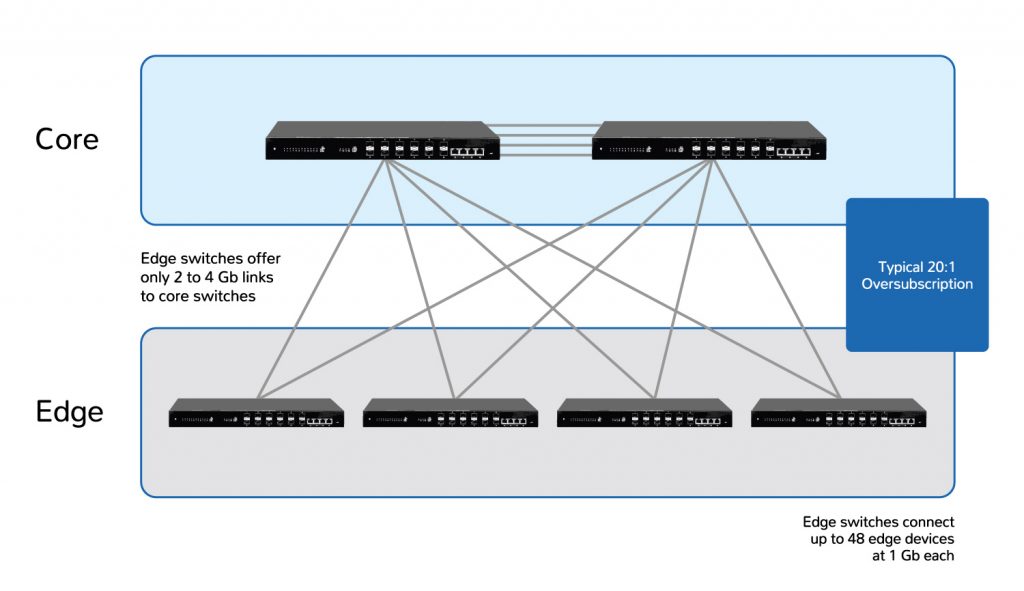AV over IP: Impossible on Your Existing Network
A whitepaper published by Crestron® “Understanding & Evaluating AV-over-IP” asserts that convergence is important and can only happen with 1G AV over IP. 1G infrastructure is “free” because you can use what you already have, claims the table on the last page.
I hear that same story all the time. “10G AV over IP? You’re better off leveraging your existing network with 1G AV over IP instead.” This is certifiably a false statement.
I’m writing to make one thing clear: adding AV over IP to your existing network will always require new infrastructure.
Interestingly, this is true whether you choose SDVoE and 10G or products limited to 1G bandwidth. Unless you’re running a strictly non-blocking network – an irresponsible waste in corporate IT – you won’t be able to use your existing infrastructure, without modification for AV.
Where is the bottleneck?
An edge switch refers to the switch that connects directly to edge devices – PCs, printers, VoIP phones. Commonly an edge switch includes 24 or 48 copper ports, with two to four fiber ports aggregating traffic back to the core of the network.
In the days of Fast Ethernet, 24 devices at 100 Mbps each generated a total bandwidth of 2.4 Gbps. Back then, a pair of 1 Gbps fiber uplinks could carry nearly all of the possible traffic to the core.
Then – nearly 20 years ago – Gigabit Ethernet reached the desktop. A 24-port switch could potentially bombard the uplinks with 24 Gbps. A pair of gigabit fiber links connecting our edge switch to the core became a potentially significant bottleneck. The obvious solution would have been to upgrade the core links to something 10 times faster than before. However, around this same time, the dot-com market crashed. Corporate technology budgets were under close scrutiny.
At this point, network engineers got a lot smarter about infrastructure. They realized that most edge devices didn’t use anywhere near 1 Gbps all the time. Traffic from edge devices is bursty. A bursty device may consume high-speed data for brief moments, but sits silently most of the time. Consider the device you are using now. It loaded this web page for you, and now sits, consuming almost no data at all, waiting for your next navigation.

Network engineers oversubscribe uplinks by 20:1 as a rule of thumb
How much bandwidth is too much bandwidth?
This means that much of the bandwidth available from your PC to the edge switch is wasted. That’s fine, since the PC doesn’t need it. But this “waste” gave the network engineers of the early 2000s an idea, laid out in this 2004 article in EE Times.
In the article, the author argues for a concept that is now the standard approach to enterprise network design: oversubscription of network links. After observing that most edge devices use less than 10% of available bandwidth, network designers chose not to upgrade their gigabit uplinks, even as the edge links were upgraded to gigabit.
With 24 gigabit devices at the edge bumping into 2 Gbps of uplinks, this is an oversubscription ratio of 12:1. When deploying 48-port switches at the edge, this can be as bad as a 24:1 oversubscription ratio.
Yet this architecture works perfectly well in corporate data network environments, because normal edge devices use so little of their bandwidth. Even though average utilization is low, congestion is still possible. Therefore quality of service (QoS) techniques like DiffServ were invented to prioritize time-sensitive Voice-over-IP traffic through the congestion, and allow less urgent traffic to be stored and sent later.
Today, the textbook recommendation to network engineers is to design in a 20:1 ratio of edge device bandwidth to uplink bandwidth.
AV over IP will kill your existing network
… if you don’t design for the new capabilities.
What happens when IT and AV live together on the same infrastructure?
Unlike your PC’s bursty web browser traffic, AV over IP consumes large amounts of bandwidth over long spans of time. When packetized using a 1G AV-over-IP technology, each video becomes a full-blown 1 Gbps multicast stream. For example, Crestron NVX streams consume up to 990 Mbps. This doesn’t work on an oversubscribed network!
You can imagine how the network admin would react if you injected multiple videos through the existing network. Video traffic must get through or video will fail. Network admins must de-prioritize emails and other cloud operations to wait or even drop when there is a bottleneck. In general this is no problem, because the sender will re-send the TCP packets. But when the priority traffic is made of 990 Mbps video streams, the result is that the regular IT traffic is never allowed through. The video traffic will literally kill the network by saturating all links in between switches.
You cannot leverage your existing network for new AV-over-IP applications, because your infrastructure is already oversubscribed, and video streams demand huge amounts of bandwidth. Instead, you will always need to build a new infrastructure for AV. Even if you choose AV-over-IP products that are restricted to 1G, you must upgrade your network’s available bandwidth to a 10 Gigabit Ethernet backbone with sufficient links in between AV switches.
In other words, there is no 10G vs 1G debate, since you need a new 10G infrastructure in both cases.


